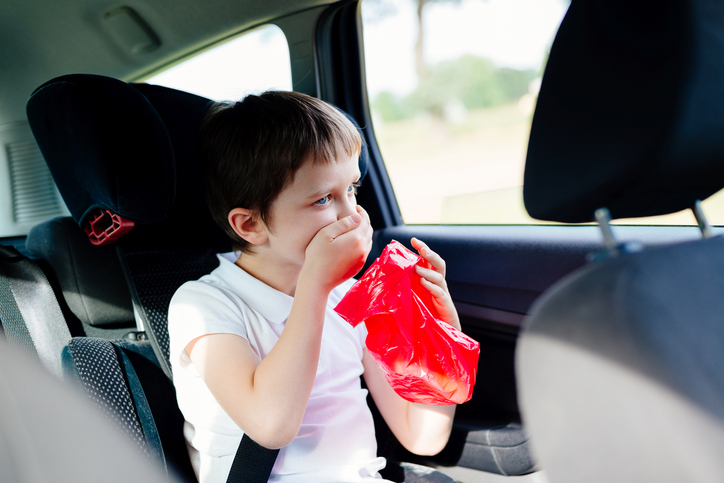Do long road trips make your child green with nausea? Motion sickness in children is extremely common.
In fact, it will affect up to half of all kids at some point, and it can make travel especially hard.
There’s usually one in every family. The child whose sensitive stomach can turn on a dime as soon as they get in a moving car, plane, or boat.
You never know when you’re going to see the color drain from their little face or hear the dreaded “Mom, I feel sick”.
In my family, that kid was me. And I can’t tell you the number of times my parents had to stop and deal with my throwing up on the side of the road.
And the fun continues into the next generation, as my young nephew has inherited the same propensity to barf at the drop of a hat.
I totally get it when I hear him say, “Auntie, I don’t feel so good”.
That’s code for pull the freaking car over…NOW!
It’s interesting, researchers have never been able to figure out why some people feel nauseous every time they get in a moving vehicle and others can travel without any discomfort.
I don’t remember my brother ever getting sick. And we were in the same car, going to the exact same place.
For those of us who do have to deal with a little one who’s prone to getting sick, understanding what causes motion sickness in children can help you prepare and potentially prevent an episode on your next trip.
Because let’s face it, cleaning vomit out of your backseat can be a real buzzkill on a family vacation.
Causes Of Motion Sickness In Children
Like we said, why motion sickness affects some children and not others is still a mystery, but for those kids who are impacted, the basic cause is the same.
Whether it happens in a car, boat, or plane; motion sickness in children occurs when there is a disconnect between what the eyes see and the motion the inner ear senses. The incoming messages get all jumbled up in what experts call a “sensory mismatch”.
So, for example, if your child is looking at a book or iPad in the backseat, his eyes are focused a few feet away, which tells the brain he is sitting still.
Meanwhile, the inner ear picks up the motion of the car and tells the brain “hey! we’re moving”. The brain gets confused, resulting in dizziness, nausea, and vomiting.
Motion sickness in children tends to strike between the ages of 2 to 12 years old. Infants are generally not susceptible.
Related: Car Hacks! Family Road Trip Essentials
Certain types of movement are more likely to set off motion sickness than others.
The rocking of a boat, for example, is a type of movement the inner ear doesn’t sense well. Amusement park rides that spin are another.
Whether or not your child gets carsick can depend on a number of factors including; the type of road, where their eyes are focused, the length of the drive, and where in the car they are sitting.
If you can learn your child’s motion sickness triggers, it can go a long way towards preventing a vomiting accident in their seat.

Motion Sickness Triggers
The trio of classic motion sickness triggers are twisty roads, frequent lane-changes, and stop-and-go traffic. For boats and planes, the amount of turbulence or chop in the water plays a significant role.
Since the goal here is to prevent vomiting accidents, it’s a good idea to learn your individual child’s symptoms so you can increase your chances of getting a warning before the sickness starts.
More: Motion Sickness Remedies For Kids That Work!
For me, about a minute before I would get car sick…all the saliva would drain out of my mouth and it would become incredibly dry. My mom trained me to let her know when this happened so she’d have time to grab a bag or pull over.
Other symptoms can be dizziness, a lurching sensation in the stomach, a feeling in the back of the throat…whatever it is, teach your child to recognize the signs so they can communicate when they are starting to feel sick.
Toddlers as young as 2 or 3 can tell you when they feel like throwing up. This can help prevent accidents.
Also, look for outward signs; like a chatty kid who all of a sudden goes silent. Or a child who turns ghostly pale and closes their eyes before they get sick.
Or in my nephew’s case, the kid who dry heaves before he actually throws up.
If you know what warning signs to watch out for it may buy you the precious seconds you need to grab a bag.
Be Prepared
If you know you’ve got a kid prone to motion sickness, you want to be prepared. Start by thinking about what you will put in their little bellies before you head out.
You might be tempted to have them travel on an empty stomach, but don’t. Not eating makes a child’s tummy more susceptible to rocking motion, which can lead to nausea.
Have them eat something bland and easy to digest before you head out. Avoid any food that is spicy, greasy, or has a strong odor.
Peanut butter toast, a plain chicken sandwich, etc. are safe bets.
Also be sure your child drinks water. Dehydration can make nausea worse.
Also In Beenke: 10 Great Tips For Traveling With Kids
Vomiting can happen at a moment’s notice. You want to have all the gear you’ll need ready to go and stashed in your car or travel bag.
That’s why we suggest putting together a little emergency kit specifically designed to handle motion sickness in children.
The first thing you’ll need? Barf bags!
Good old-fashioned ziplock freezer bags will work in a pinch. But we actually like using biodegradable, odor-resistant diaper bags for this purpose.
The reason being they’re better for the environment, and they help mask the god-awful vomit smell.
Remember, it may be a few minutes before you get to a location where you can toss the bag into the trash.
We’ve had the experience where one child smells the vomit of another child and they end up throwing up too! So anything you can do to cover up the smell is a good idea.
Make sure you store bags in both the front and backseat where anyone can grab one in case of emergency.
Here’s a complete list of potential items for your on-the-go motion sickness kit. If you’ve got these packed, you’re already ahead of the game!

Motion Sickness Kit:
-
- Tadge Goods Baby Disposable Biodegradable Diaper Bags w/ Lavender Scent & Added Baking Soda To Absorb Odors
- Biokleen Bac-Out Stain+Odor Remover Foam Spray (in case you need to clean up your seats)
- Febreze AIR Freshener (to really get the smell out!)
- Handheld Fan Mini Portable Battery Operated Electric Fan (air helps)
- Gel Ice Cold Compress (cold helps too)
- Sea-Band Children’s Travel Sickness Wristband
- Queasy Drops
- Biotene Fresh Mint Moisturizing Oral Rinse Mouthwash (to rinse the taste out after)
- Nausea Relief Oil Synergy Blend
- Change Of Clothes (in case one set gets thrown up on)
A sick child can make travel miserable, but the good news is that motion sickness can be treated. Check out these tried and true Motion Sickness Remedies For Kids.
The right combination of home remedies and/or medicine, coupled with being prepared by having a motion sickness kit close at hand will, help you beat motion sickness in children.
This means happier travels for the whole family!
Related: Car Hacks! Family Road Trip Essentials
SHARE what causes motion sickness in children with friends on Facebook or Pinterest by clicking the buttons below.












